Red-Bellied Black Snake (original) (raw)
Around 35 people are bitten by these snakes each year, however there have been no recorded fatalities.
The red-bellied black snake is a semi-aquatic, carnivorous species of venomous snake native to Australia. The bite of these snakes is toxic, but they are not considered an aggressive species. Despite their shy nature, they still bite about three dozen people annually, though there aren’t any confirmed deaths. They are one of the most common snakes found in the eastern part of Australia.
5 Amazing Facts About Red-Bellied Black Snakes!
- Female red-bellied black snakes have a different hinge mechanism in their jaw from males.
- This species has gone through eight separate scientific names!
- These snakes give birth to live offspring, around 22.8 cm or 9 inches, rather than laying eggs.
- The only difference between a juvenile red-bellied black snake and an adult is the size.
- Indigenous populations referred to these snakes as “djirrabidi.”
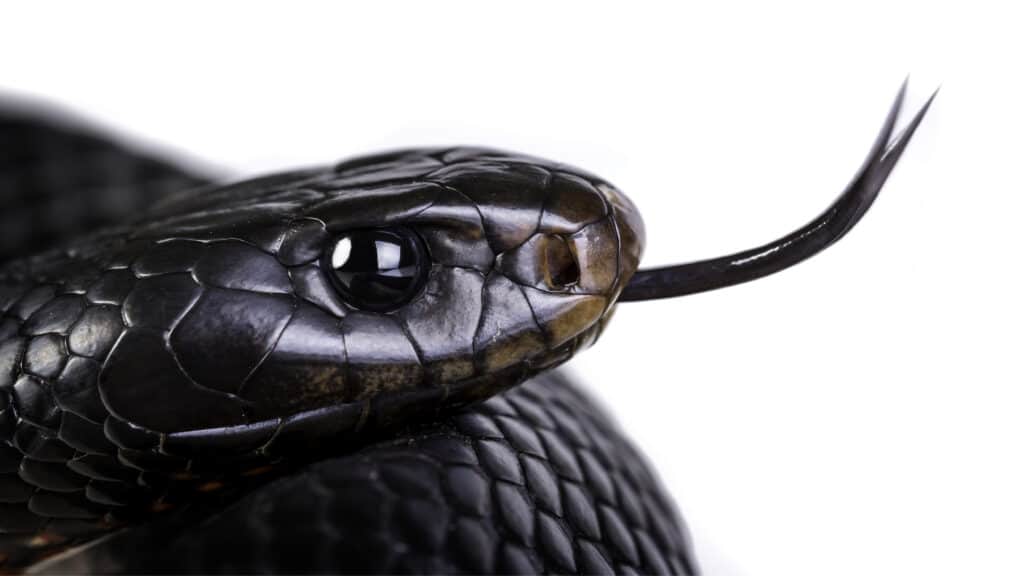
The hinge mechanism in this snake species’ jaw differs between females and males.
©Paul Looyen/Shutterstock.com
Scientific Name
Red-bellied black snakes are one of the least venomous of the Elapidae family of snakes. The scientific name for the red-bellied black snake is Pseudechis porphyriacus. This scientific name means “red-purple false viper” in Latin and Greek.
This snake was first described in 1794 and has had several scientific names during that time before receiving its current one. Originally it was known as Coluber porphyriacus because it was incorrectly believed to be non-venomous. The red-bellied black snake over the years has been named Trimeresurus leptocephalus, Naja porphyrica, Acanthophis tortor, and Trimeresurus porphyreus, and a couple of misspellings of its current name. These snakes are also called the common black snake, red-belly, RBBS, and several indigenous names. No subspecies have been confirmed, although some believe there may be at least two potential subspecies.
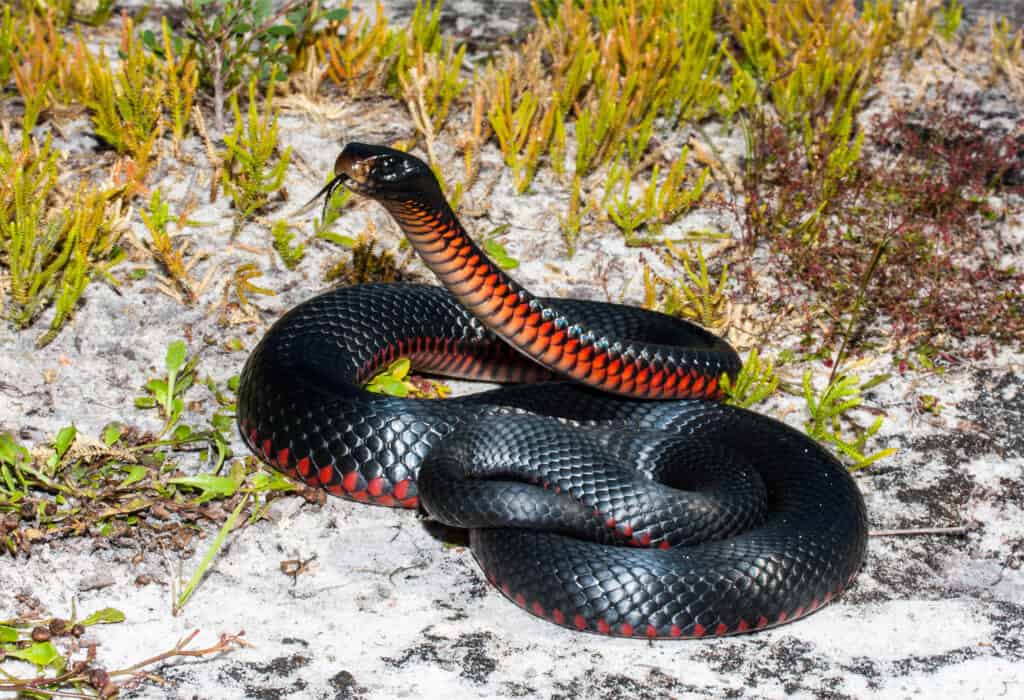
This species’ scientific name means “red-purple false viper” in Latin and Greek.
©Ken Griffiths/Shutterstock.com
Evolution and History
There is a possibility that these snakes adapted to their environment in response to the threat of the cane toad. Native to South and Central America, cane toads were introduced to Australia in 1935 in an effort to control beetles that were destroying sugar cane crops but unfortunately these predators with voracious appetites became an invasive species. A study published in 2016 showed that red-bellied black snakes have developed an increased resistance to the toxins of cane toads and a reduced desire to prey on them. This suggests the snake’s behavior and physiology have undergone a rapid evolution, within 23 generations, due to cane toads.
While all other species in the genus Pseudechis lay eggs, red-bellied black snakes give birth to live young. This is beneficial for females living in cooler climate habitats as it gives them more control over the temperature during the reproductive process.
Appearance
A red-bellied black snake’s size is distinctive, reaching 1.4-1.8 m (4.5-6 feet) in length. The top part of its body is a shiny solid black, while the underbelly is several shades of red. The head of this snake transitions seamlessly into its body, with no distinguishable neck. They are very similar in appearance to a blue-bellied black snake, save for the belly color. Other similar snakes include the Eastern brown snake, Inland taipan, and carpet python.
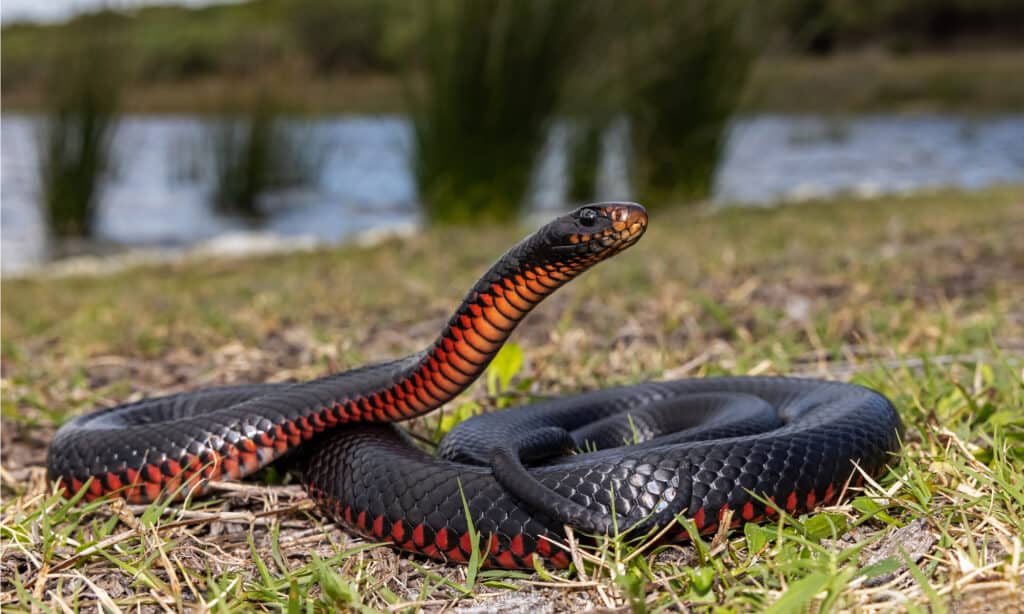
The red-bellied black snake has no discernible neck.
©Ken Griffiths/Shutterstock.com
Behavior
Red-bellied black snakes are timid; in most cases, they would rather slither away than attack a human. The only possible exception is when a female is pregnant and defending her babies. However, they are not an aggressive species and for their size, their venom is comparatively one of the weakest of the elapids.
The venom from a red-bellied black snake bite can cause a lot of issues. It keeps blood from clotting, so the bites bleed a lot. In addition to redness and swelling, the venom can cause nausea, vomiting, diarrhea, muscle pain, sweating, weakness, headache, urine discoloration, and abdominal pain.
Every year, about 35 people are bitten by these snakes. Because this snake is so common throughout eastern Australia and is so frequently encountered by humans, that is actually a very low number. However, there aren’t any confirmed deaths from its bite. There are a few older records that say its bite killed someone, but these have never been confirmed.
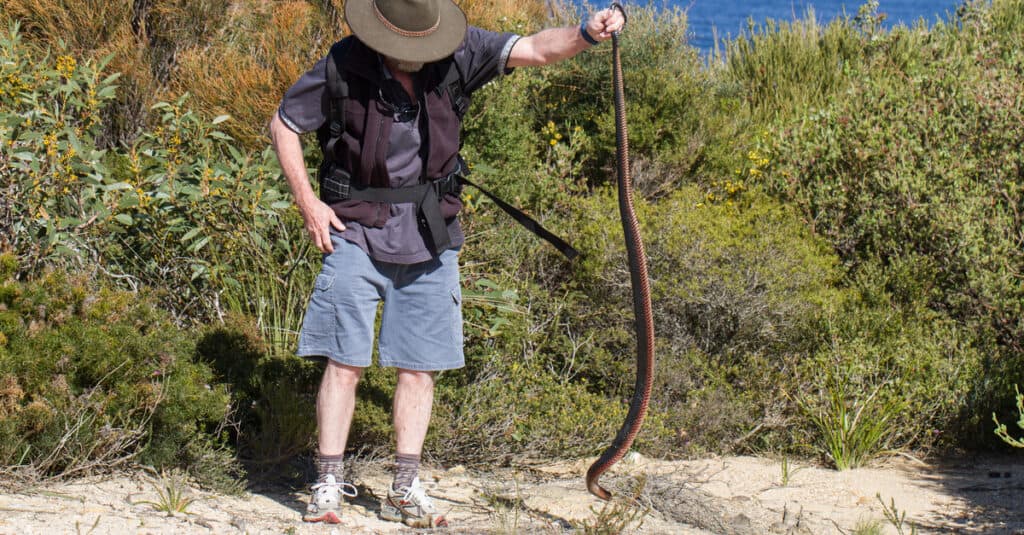
About 35 people are bitten by red-bellied black snakes each year.
©Ken Griffiths/Shutterstock.com
Habitat
These snakes are indigenous to the east coast of Australia, including Victoria, New South Wales, and Queensland, and a population is also in South Australia. They are semi-aquatic and often live near bodies of water. They can be found in or near woodlands, grasslands, forests, swamps and other wetlands, streams, and shallow rivers. They prefer tall, thick vegetation to hide in, but they are cold-blooded, so they also like areas with patches of direct sunlight. They are sometimes found near drainage ditches.
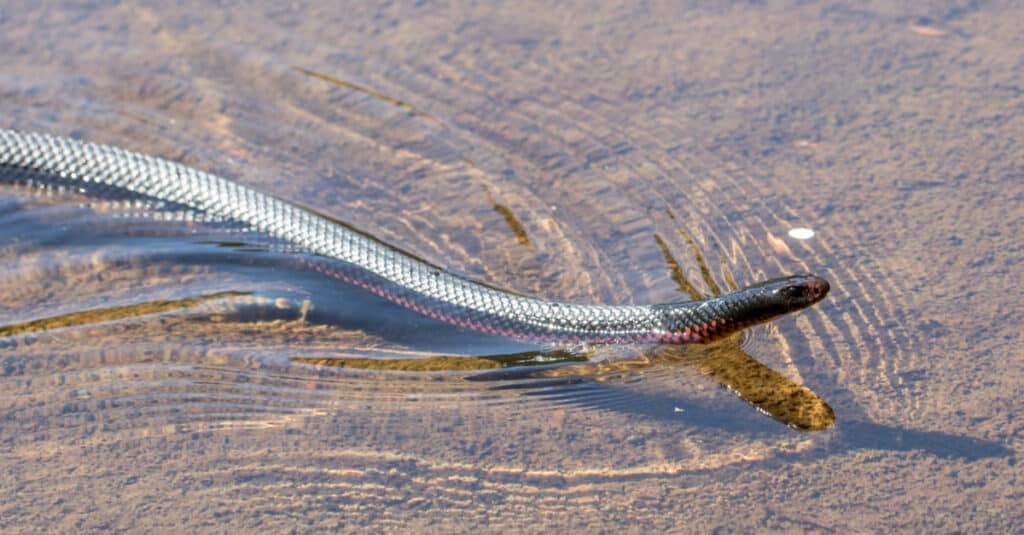
Red-bellied black snakes often live near and hunt in shallow water.
©Ken Griffiths/Shutterstock.com
Diet
Red-bellied black snakes are carnivorous, with their diet mainly consisting of frogs and tadpoles. They also eat lizards, fish, eggs, small mammals, and snakes. They are cannibalistic and will not only eat other snakes but eat their own species.
They are opportunistic when it comes to food sources and as they are semi-aquatic they are able to hunt prey underwater typically by dipping in either their heads or tails but also by swimming.
These snakes have been observed to eat their food fast, consuming it before the venom has taken effect.
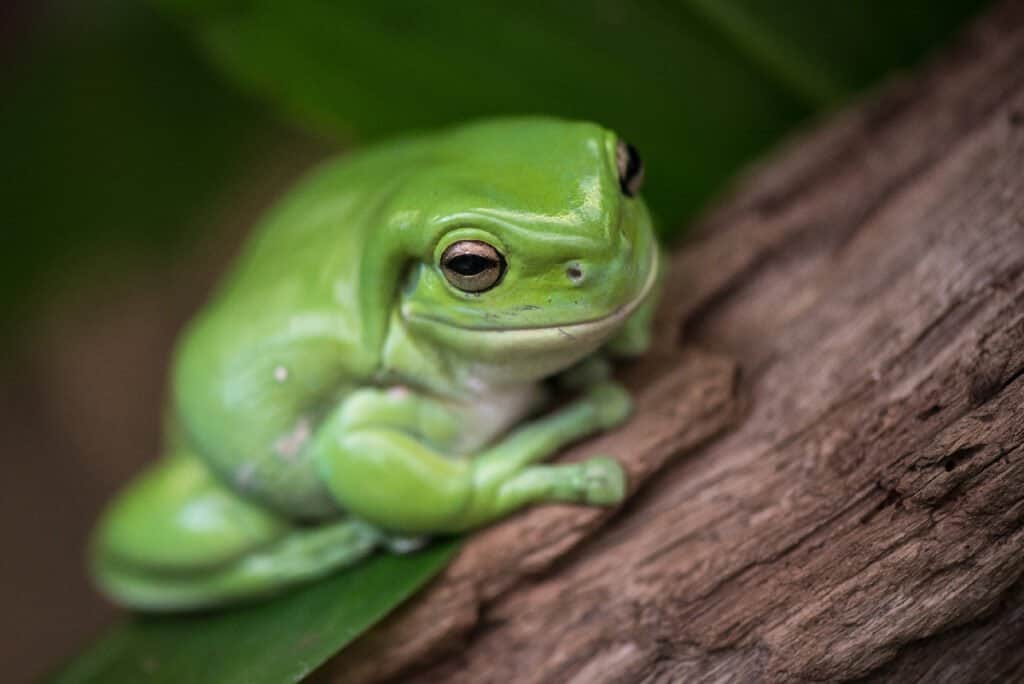
Frogs form a large part of the red-bellied black snake’s diet.
©iStock.com/Jennifer Sophie
Predators and Threats
The primary predators of red-bellied black snakes are feral cats, large birds of prey such as the brown falcon, and humans.
Baby or young red-bellied black snakes are more vulnerable and targeted by a larger number of predators including birds such as kookaburras, larger snakes, frogs, and redback spiders. If a snake consumes a cane toad, which is a widespread invasive species in Australia, it can die as the toxins in the toad are strong enough to kill it.
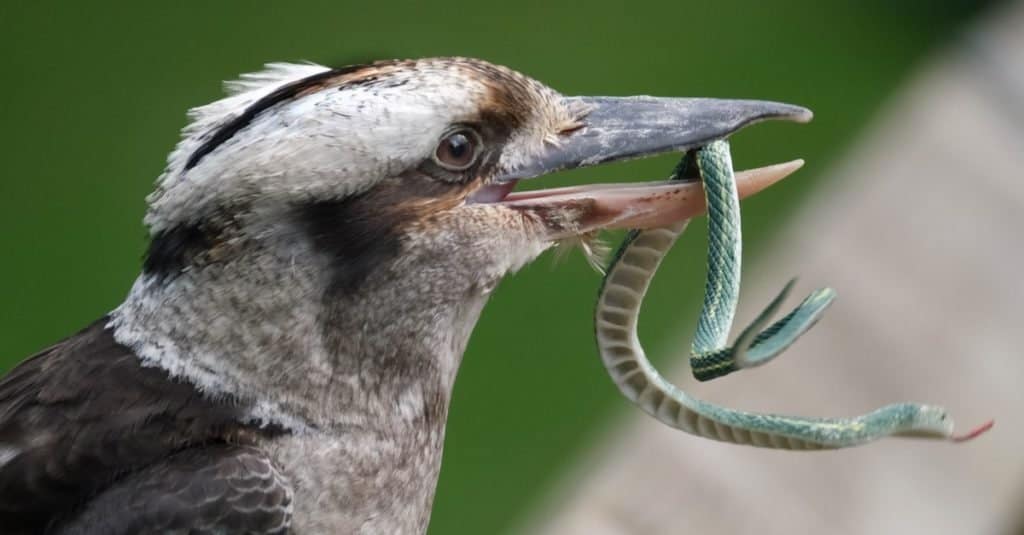
Kookaburras prey on juvenile snakes including the red-bellied black snake.
©Paulpixs/Shutterstock.com
Reproduction and Lifespan
Male and female red-bellied black snakes can have multiple partners during the breeding season, which occurs usually in October and November but can be as early as July to September. Males will seek out suitable mates by traveling up to 1.2 km or 4,002 feet per day and if more than one male is competing for a female’s attention, they will battle it out.
Females sometimes congregate together toward the end of a pregnancy. A few individuals will group together when they rest, presumably following the ”safety in numbers” idea, but no one knows for sure why.
The gestation period is for 4-5 months, with the female red-bellied black snake birthing 5-18 live young that typically are around 22.8 cm (9 in) and weigh about 10.1-11 g (0.35-0.38 oz) that are instantly independent. Red-bellied black snakes reach sexual maturity at around 2-3 years.
It’s not known how long red-bellied black snakes live in the wild. In captivity, the longest lifespan recorded for these snakes is 11 years.
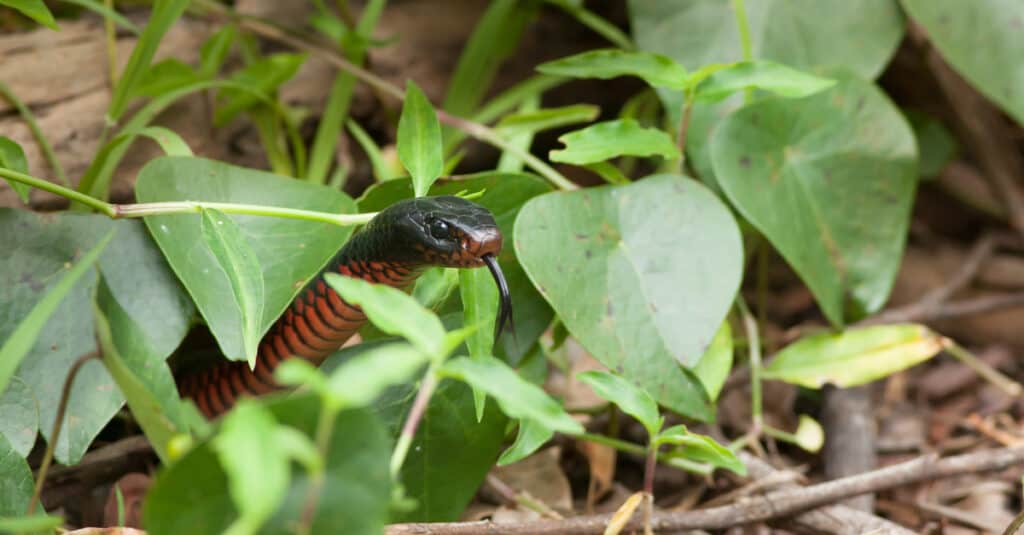
The male red-bellied black snake will travel long distances to seek out a suitable female mate.
©Belle Ciezak/Shutterstock.com
Population and Conservation
While there is no known estimate of how big the red-bellied black snake population is, these snakes are listed as being of Least Concern by the IUCN. Since they can give birth to up to 18 live babies at a time, with the size of the young also an advantage, and live in so many different habitats, they are not at high risk of decreased population at this time.
As they live on a varied diet of lizards, fish, frogs, and other snakes, their food sources are plentiful. In addition, they can also hunt in or out of water.
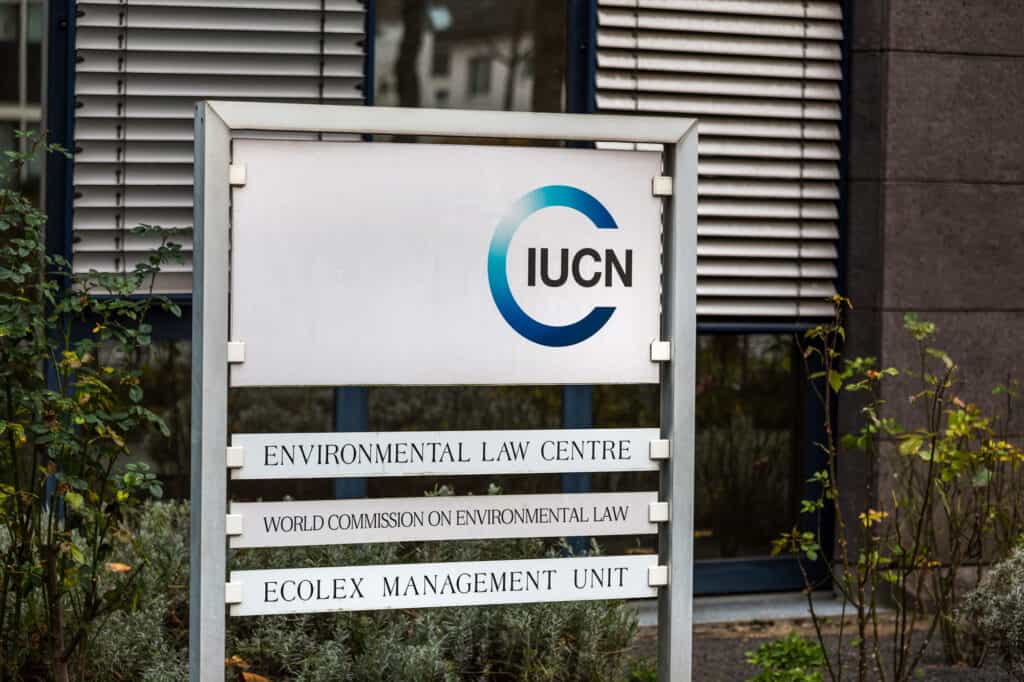
The IUCN lists the red-bellied black snake as Least Concern.
©Tobias Arhelger/Shutterstock.com
View all 154 animals that start with R
A red-bellied black snake is not poisonous, but it is venomous. It is not an aggressive species and for its size, its venom is comparatively weak.
No, though red-bellied snakes are somewhat rare, red-bellied black snakes are not.
The venom of a red-bellied black snake is quite toxic to humans, though bites are relatively uncommon with fewer than three dozen per year, but there are no recorded deaths as a result of the venom from their bite.
Red-bellied black snakes are found in the swamps, wetlands, woodlands and grasslands of the east coast of Australia.
It is called a red-bellied black snake because the snake is primarily black, with a red underbelly.